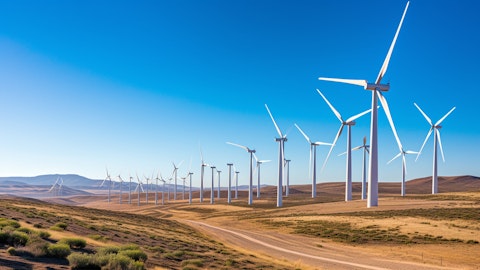Plug Power Inc. (NASDAQ:PLUG) Q3 2023 Earnings Call Transcript November 9, 2023
Operator: Greetings, and welcome to the Plug Power Third Quarter Earnings Call. At this time, all participants are in a listen-only mode. A brief question-and-answer session will follow the formal presentation. [Operator Instructions] As a reminder, this conference is being recorded. It is now my pleasure to introduce your host Teal Hoyos, Director of Marketing and Communications. Thank you, Teal. You may begin.
Teal Hoyos: Thank you. Welcome to the 2023 third quarter earnings call. This call will include forward-looking statements. These forward-looking statements contain projections of future results of operations or our financial position or other forward-looking information. We intend these forward-looking statements to be covered by the Safe Harbor provisions for forward-looking statements contained in Section 27A of the Securities Act of 1933 and Section 21E of the Securities Exchange Act of 1934. We believe that it is important to communicate our future expectations to investors. However, investors are cautioned not to unduly rely on forward-looking statements, and such statements should not be read or understood as a guarantee of future performance or results.
Such statements are based upon the current expectations, estimates, forecasts, and projections as well as the current beliefs and assumptions of management and are subject to significant risks and uncertainties that could cause actual results or performance to differ materially from those discussed as a result of various factors, including, but not limited to the risks and uncertainties discussed under Item 1A Risk Factors in our annual report on Form 10-K for the fiscal year ended December 31, 2022, quarterly reports on Form 10-Q for the quarters ending March 31, 2023 and June 30, 2023 and other reports we file from time to time with the SEC. These forward-looking statements speak only as of the date which the statements are made, and we do not undertake or intend to update any forward-looking statements after this call or as a result of new information.
At this point, I would like to turn the call over to Plug Power’s CEO, Andy Marsh.

Andrew Marsh: Thank you, Teal, and thank you for joining the third quarter conference call. It’s a difficult quarter, driven primarily by the availability of hydrogen. Over the past several months, there has been enormous challenges associated with the availability of hydrogen, primarily due to down plants, including our Tennessee facility and temporary plant outages across the entire hydrogen network. For many days, demand outstripped supply. For example, many of the California fueling stations have been without fuel or had limited fuel on a regular basis over the past several months. Additionally, the price of these stations for hydrogen has been over $30 per kilogram at the pump, about twice the normal price. To service our customers, Plug has been moving hydrogen from the West Coast to the East Coast.
This has been a yeoman’s effort and has been accomplished while reducing the core cost of hydrogen compared to the second quarter. Good news is the network has now stabilized and many of these planned outages have subsided, plus additional capacity will be coming online. We expect our Tennessee plant will be back online producing hydrogen by the end of the year. This plant when fully operational provides about 20% of our production needs. One of our major suppliers is upgrading one of their facilities to allow the plant to operate at full nameplate capacity in the coming months. The planned output has been producing between 0% to 25% of capacity. We are continuing to see progress at our Georgia plant, and we are finishing the last step in the construction process, commissioning the liquefier.
We expect the plant to be online by year-end. A few other points, Plug’s hydrogen network also caused the delay of deployment of some of our North American material handling customers. These sites will be commissioned as the hydrogen issues resolved. It’s just a timing issue. Many of those facilities actually the fuel cells in hydrogen plant or infra fueling structure are already available. We believe though that this experience reaffirms the criticality of building our nationwide hydrogen network to support our fuel cell business as well as the financial benefits that this network could accrue to the company for both that business and the additional applications that are beginning to be realized. Furthermore, this experience underscores the wisdom of our business diversification model.
In the fourth quarter, we anticipate the revenue from our new ventures will surpass revenue from our traditional business for the first time as our electrolyzers and cryogenic businesses continue to grow. Finally, I’d like to just like to reflect on the conversation I had yesterday morning with a European customer supplier and partner. He gets toward our facilities and remind me that no one has built hydrogen infrastructure on the scale we have. No one has our product set, no one has technical talent, no one has our customer relationships and no one has our real life experiences. It remains our belief and his there is the market for hydrogen fuel cell grows, no one is in a better position than Plug to take advantage of this opportunity. This is just a bump on the road.
Paul, Sanjay and I are now available for questions.
See also 12 Most Powerful Countries in the Middle East Heading into 2024 and 20 Most Valuable Fast Food Companies in the World.
Q&A Session
Follow Plug Power Inc (NASDAQ:PLUG)
Follow Plug Power Inc (NASDAQ:PLUG)
Operator: Great. Thank you. We will now be conducting a question-and-answer session. [Operator Instructions] Our first question comes from the line of Colin Rusch with Oppenheimer. Please proceed with your question.
Colin Rusch: I want to start off with the balance sheet. You’ve got a fair amount of restricted cash. You offered a fairly reasonable update in the letter on your process with potential funding sources. I guess the real question is around timing and how you see your ability to free up some of that restricted cash and start to bring on some of those closed one or more of those deals that you’re talking about in the shareholder letter?
Andrew Marsh: Hi. Sure, Colin. I’m going to let Paul take that question.
Paul Middleton: Good afternoon, Colin. Thanks for the question. We continue to pursue a number of initiatives. We’ve had many inbound expressions of interest with different terms, and we continue to work through what we think is the best and most prudent solution. It’s not for lack of options. It’s really just continue to be picky around which ones that we’ve had to act on, and we haven’t felt the compulsion to act quickly. To be — we’re taking our time to be thoughtful about which choices that we have. I’ll tell you on the DOE process, many, many people will ask about that. That’s — we’re progressing very well. We continue to have great effort in collaboration with them. And we expect that, that will get through the 100-page long-form term sheet that they need to get through to submit for contingent approval here by the end of November.
And we still expect there’s a good chance we can announce that program by the end of the year, that will be very meaningful. And we continue to pursue a range of other options. And so I expect something in the near term.
Colin Rusch: Okay. And then on the operations side, with the impact around the hydrogen availability, can you talk about the cadence of deployments for material handling and how that’s impacting some of the equipment sales that you guys are working through for the balance of the year and into the early part of 2024?
Andrew Marsh: Yeah. So Colin, we had — we left the quarter with seven sites which we couldn’t bring online, which would have represented well over $50 million in revenue because of, we couldn’t put more stress on the network. And so we expect that we will have a good quarter for material handling. I’m just going to caveat it by saying that first and foremost, we have to make sure, especially during this holiday season, going peak that our key customers have hydrogen. And as I mentioned, we’ve done a really good job in moving hydrogen. Without our fleet of over 40 trucks, we would have never been able to do what we were able to do. So I — in my opening comments, I said it was a timing issue. I think if the network continues to improve, it probably will happen this quarter.
But I think there probably could be — when I think about our material handling business, it will swing of between up to about $50 million, I think, is possible. That being said, and I think the letter highlighted this. Some of those customers that we’ve gone through this with have actually increased their number of system — a number of material handling sites they want. We’ve added new customers, Tyson. We’ve added new customers, Rider and others. So it’s — it has not — it certainly has been a challenging time, but it’s pretty remarkable how well we’ve done so far in keeping hydrogen available for our customers.
Colin Rusch: Thanks and appreciate it, Andy.
Andrew Marsh: Yes. You’re welcome.
Operator: Thank you. Our next question comes from the line of Manav Gupta with UBS. Please proceed with your question.
Manav Gupta: Hey, guys. So help us understand the path to positive gross margin here. I think that’s the number one question we are getting. How do you get to positive gross margin and by when?
Andrew Marsh: Sure. Paul, do you want to take that? And I may have some — I may add on some items, but do you want to take it, explain how we get there?
Paul Middleton: Yeah. Sure, Andy, and thanks for the question. I would tell you a couple of fundamental things. One, Andy mentioned this quarter, the revenue from these new platforms are going to be greater than our legacy business. Most of those platforms and really all of them are equipment platforms. And I don’t know, if you’ve seen our new facility up in Vista or Rochester, but we’re poised as we start scaling all these new platforms up for substantial volume leverage. And so — and if you look at sales in Q4 and on into — and into next year, really, the bulk of the growth is coming from these equipment platforms. And we’ve shown historically with material handling as we scale that business, that every time we double the installed fleet, we’ve been able to reduce the cost by 25%, and you’re going to see the same trends.
As we get volume leverage, you get supply chain leverage, you drive greater automation. So equipment sales is really key, and that’s one thing you’re going to see as we move past launching these new platforms and through the pilot programs and to really scaling them. Second thing you’ll see is on the fuel margin. You already see some abatement in the prices. We expect some additional abatement in Q4, but the real step function change in fuel happens as we turn on our own facilities. And so Georgia is coming online this quarter. Tennessee will be reinstating and turn that back up. And then we’re looking to turn on the new facility in Louisiana towards the end of Q1. And so those will be very accretive events as we start to turn those facilities up and start to be able to source a lot of that hydrogen from ourselves, which, in many cases, is at least 30% cheaper — or I’m sorry, is 30% of the market cost that we’re paying today.





